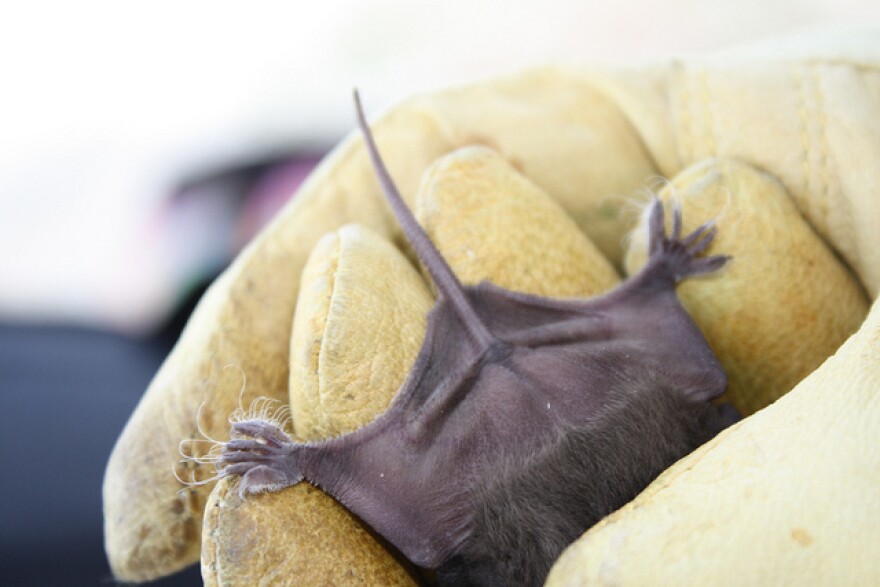We’re heading up the road this week to get acquainted with bats at Pinnacles National Park, just south of the Bay Area—a place you’ll want to visit now and in to spring—and also in Yolo County quite close by, where summer is the time to go batty.

Bats have gotten a very bad rap among humans, and quite unfairly, given that they are huge insect eaters and spend much of their time controlling the pests that bedevil farmers and gardeners and indirectly affect our food supply. All kinds of crazy myths and beliefs about bats have developed over time, and even today people tend to think most are rabid or otherwise pose some threat to humans. It’s true that no one should pick up or otherwise mess with any nocturnal creatures, including bats, that you find out and about during the day. (Call an expert, such as Northern California Bats in Davis.) But most bats don’t carry rabies, and don’t pose a threat. In fact, we humans pose a serious threat to bats, fellow mammals that nurse their young—called pups—with milk, just like we do. Bats have very particular requirements to successfully roost, feed, and otherwise thrive, and here in California we have been taking over those habitats since the days of the Gold Rush, transforming them to suit our own needs.
It just so happens that several bat species can be observed fairly up close and personal here in Northern and Central California. Get to know more about the gentle Townsend’s Long-Eared Bat (sometimes called Big-Eared) in and around the caves at Pinnacles National Monument, otherwise a destination otherwise best known as a rock-climber’s winter paradise. (Winter because summers are shadeless and brutally hot.) This is the largest maternity colony between San Francisco and Mexico.
Townsend’s long-ears are cave and mineshaft dwellers that hibernate hanging by one foot. Pups can fly by the time they are three weeks old. These gentle bats may permanently abandon a roosting or maternity ward after people disturb them, so access to caves at Pinnacles is controlled accordingly. Worse yet, individual bats flushed out during hibernation, forced to burn their dwindling fat reserves, may not survive the winter. It’s so often true that we humans just don’t know the harm we do. The Townsend’s colony inhabits the Bear Gulch Cave; at least the lower cave is accessible most of the year (see the park website for details), and equally rare Western Mastiff Bats live in and around Balconies Cave. Of California’s 23 native bat species, you’ll find 14 of them at Pinnacles National Park.
To get you oriented otherwise to Pinnacles, originally a national monument established by President Teddy Roosevelt himself: Visiting these volcanic spires and ravines is a little like landing on the moon. The weird dark-red rocks are bizarrely eroded, unlike anywhere else in North America, forming gaping gorges, crazy, caverns, terrifying terraces. Excellent trails, though—in fact, you can get from the park’s west side to east side only by trail—with pebbles the size of houses to stumble over. If you’re afraid of earthquakes you should know that the Pinnacles sit atop an active section of the San Andreas Fault. In addition to bat watching, in winter you can observe the raptors out hunting: golden eagles, red-shouldered hawks, kestrels, and prairie falcons.

Summer is the time to commune with the migratory, similarly threatened Mexican Free-Tailed Bats of Yolo County, where guided Bat Talk and Walks are offered for a fee in the Yolo Bypass Wildlife Area. The free-tails roost under bridges, roof tiles, building eaves, and in caves, and primarily eat moths, flying as high as 10,000 feet to snag them. But they also eat stink-bugs, weevils, flying ants, and various ground beetles. You’ll want to be there for the evening “fly-out,” around sunset, when thousands emerge in controlled but seemingly chaotic columns of bug-hunters. In addition to deliberate attempts to eradicate or evict them from their homes—People! They help keep bugs under control!—these bats also suffer from pesticide poisoning, not all that uncommon with other species either in ag areas. When Mexican free-tailed bats are out hunting too early or too late, red-tailed hawks may end up hunting and then snacking on them, a little of that what-goes-around-comes-around we’re all so familiar with.




